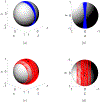Dynamics of deformable straight and curved prolate capsules in simple shear flow
- PMID: 31777765
- PMCID: PMC6880959
- DOI: 10.1103/PhysRevFluids.4.043103
Dynamics of deformable straight and curved prolate capsules in simple shear flow
Abstract
This work investigates the motion of neutrally-buoyant, slightly deformable straight and curved prolate fluid-filled capsules in unbounded simple shear flow at zero Reynolds number using direct simulations. The curved capsules serve as a model for the typical crescent-shaped sickle red blood cells in sickle cell disease (SCD). The effects of deformability and curvature on the dynamics are revealed. We show that with low deformability, straight prolate spheroidal capsules exhibit tumbling in the shear plane as their unique asymptotically stable orbit. This result contrasts with that for rigid spheroids, where infinitely many neutrally stable Jeffery orbits exist. The dynamics of curved prolate capsules are more complicated due to a combined effect of deformability and curvature. At short times, depending on the initial orientation, slightly deformable curved prolate capsules exhibit either a Jeffery-like motion such as tumbling or kayaking, or a non-Jeffery-like behavior in which the director (end-to-end vector) of the capsule crosses the shear-gradient plane back and forth. At long times, however, a Jeffery-like quasiperiodic orbit is taken regardless of the initial orientation. We further show that the average of the long-time trajectory can be well approximated using the analytical solution for Jeffery orbits with an effective orbit constant C eff and aspect ratio ℓ eff. These parameters are useful for characterizing the dynamics of curved capsules as a function of given deformability and curvature. As the capsule becomes more deformable or curved, C eff decreases, indicating a shift of the orbit towards log-rolling motion, while ℓ eff increases weakly as the degree of curvature increases but shows negligible dependency on deformability. These features are not changed substantially as the viscosity ratio between the inner and outer fluids is changed from 1 to 5. As cell deformability, cell shape, and cell-cell interactions are all pathologically altered in blood disorders such as SCD, these results will have clear implications on improving our understanding of the pathophysiology of hematologic disease.
Figures












Similar articles
-
Multiplicity of stable orbits for deformable prolate capsules in shear flow.Phys Rev Fluids. 2020 Feb;5(2):023603. doi: 10.1103/physrevfluids.5.023603. Epub 2020 Feb 28. Phys Rev Fluids. 2020. PMID: 34095645 Free PMC article.
-
Three-dimensional dynamics of oblate and prolate capsules in shear flow.Phys Rev E Stat Nonlin Soft Matter Phys. 2013 Nov;88(5):053021. doi: 10.1103/PhysRevE.88.053021. Epub 2013 Nov 26. Phys Rev E Stat Nonlin Soft Matter Phys. 2013. PMID: 24329365
-
Effect of weak fluid inertia upon Jeffery orbits.Phys Rev E Stat Nonlin Soft Matter Phys. 2015 Apr;91(4):041002. doi: 10.1103/PhysRevE.91.041002. Epub 2015 Apr 28. Phys Rev E Stat Nonlin Soft Matter Phys. 2015. PMID: 25974430
-
Blood Rheology: Key Parameters, Impact on Blood Flow, Role in Sickle Cell Disease and Effects of Exercise.Front Physiol. 2019 Oct 17;10:1329. doi: 10.3389/fphys.2019.01329. eCollection 2019. Front Physiol. 2019. PMID: 31749708 Free PMC article. Review.
-
Flow measurements in a model of the mildly curved femoral artery of man.Monogr Atheroscler. 1990;15:96-108. Monogr Atheroscler. 1990. PMID: 2404202 Review.
Cited by
-
Multiplicity of stable orbits for deformable prolate capsules in shear flow.Phys Rev Fluids. 2020 Feb;5(2):023603. doi: 10.1103/physrevfluids.5.023603. Epub 2020 Feb 28. Phys Rev Fluids. 2020. PMID: 34095645 Free PMC article.
-
Marginated aberrant red blood cells induce pathologic vascular stress fluctuations in a computational model of hematologic disorders.Sci Adv. 2023 Dec;9(48):eadj6423. doi: 10.1126/sciadv.adj6423. Epub 2023 Nov 29. Sci Adv. 2023. PMID: 38019922 Free PMC article.
-
The Shape and Function of Solid Fascias Depend on the Presence of Liquid Fascias.Cureus. 2020 Feb 10;12(2):e6939. doi: 10.7759/cureus.6939. Cureus. 2020. PMID: 32190491 Free PMC article. Review.
-
Flow-induced segregation and dynamics of red blood cells in sickle cell disease.Phys Rev Fluids. 2020 May;5(5):053101. doi: 10.1103/physrevfluids.5.053101. Epub 2020 May 4. Phys Rev Fluids. 2020. PMID: 34095646 Free PMC article.
References
-
- Mohandas N and Evans E, “Mechanical properties of the red cell membrane in relation to molecular structure and genetic defects,” Annu. Rev. Biophys. Biomol. Struct 23, 787–818 (1994). - PubMed
-
- Goldsmith HL, Marlow J, and MacIntosh FC, “Flow behaviour of erythrocytes. I. Rotation and deformation in dilute suspensions,” Proc. R. Soc. Lond., B, Biol. Sci 182, 351–384 (1972).
-
- Fischer TM, Stohr-Lissen M, and Schmid-Schonbein H, “The red cell as a fluid droplet: tank tread-like motion of the human erythrocyte membrane in shear flow,” Science 202, 894–896 (1978). - PubMed
-
- Abkarian M, Faivre M, and Viallat A, “Swinging of red blood cells under shear flow,” Phys. Rev. Lett 98, 188302 (2007). - PubMed
-
- Skotheim JM and Secomb TW, “Red blood cells and other nonspherical capsules in shear flow: Oscillatory dynamics and the tank-treading-to-tumbling transition,” Phys. Rev. Lett 98, 078301 (2007). - PubMed
Grants and funding
LinkOut - more resources
Full Text Sources
Research Materials
